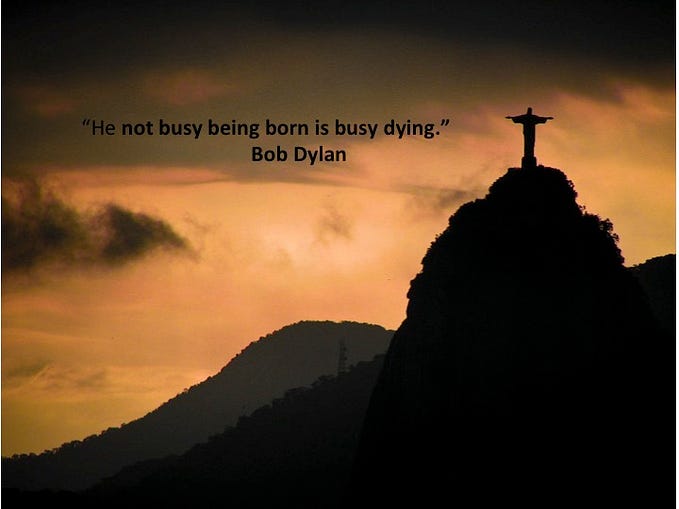
Do More! What Amazon Teaches Us About AI and the “Jobless Future”
We hear again and again that AI and robots are going to take away human jobs. My broken kettle says otherwise.
Yesterday, I set my electric kettle down awkwardly on the edge of the sink. Crash! It toppled over and smashed. I searched Amazon for a replacement, found several that were highly rated, and within minutes had placed an order. As a Prime customer, I had the option for same day delivery, by 6 pm, and so I brewed this morning’s tea without interruption or inconvenience.
Remember when it was amazing that Amazon offered free two-day shipping? Then free one-day shipping? Now for many products, it’s a matter of hours before your order is on your doorstep.
Amazon is constantly upping the ante. It doesn’t just cut costs. It uses technology to do more, delighting customers with better service and lower prices. And of course, Amazon’s customers respond by buying more products. Amazon grows faster, invests more, and delights more customers, who buy more, in a virtuous circle.
This is an example of what Jeff Bezos calls “the Flywheel.”

Far too many companies seem to miss the point that lower cost structure, lower prices, and a broader selection are only part of the flywheel. Unless it all adds up to better customer experience, the flywheel wobbles, and eventually loses its momentum.
What does all this have to do with AI and the jobless future? Take a look at this chart showing the increase in employment at Amazon during the three years that it went from 1,400 robots in its warehouses to 45,000:

I spoke recently with a fulfillment and logistics executive at Amazon who told me that robots have allowed the company to pack more products into its warehouses, and to speed up picking, so that it can put more products into rapid fulfillment. Amazon expects to hire another 100,000 workers in the next eighteen months, many of them in its fulfillment centers.
And that doesn’t include all the people working in actual delivery. Do you remember when the United States Post Office was seemingly on its last legs, cutting services and delivery hours? If you’re like me, you’re now getting multiple deliveries per day, and the postman might well show up in the evening, working overtime. Amazon Flex, Amazon’s peer-to-peer delivery service (akin to Lyft or Uber, but for delivery only) is apparently growing so rapidly that it may overtake Lyft as the second largest source of employment for on-demand drivers.
Nor does it include employment at the more than 100,000 small companies that use Amazon’s platform to sell and distribute their own goods. Many of these companies would have no access to the market without Amazon. (My brother is a good example. He runs a small distribution business out of a warehouse in Front Royal, VA, shipping used books, auto parts, and various imported products he thinks his customers might find interesting.)
Amazon reminds us again and again that it isn’t technology that eliminates jobs, it is the short-sighted business decisions that use technology simply to cut costs and fatten corporate profits.
This is the master design pattern for applying technology: Do more. Do things that were previously unimaginable.
Now, you might think that same-day delivery is a slender reed on which to hang dreams of a better future, one more technology solution to a “first world problem.” But the revolution in logistics will spread far beyond more quickly meeting the needs of people who already have everything. Zipline, the on-demand drone delivery startup, is a good example. They aren’t delivering consumer goods, but vital blood supplies and medicine, leapfrogging the need for 20th century roads and hospital infrastructure, bringing life-saving blood to clinics and small local hospitals anywhere in Rwanda within 15 or 20 minutes. (Post-partum hemhorrage is one of the leading causes of death in Rwanda because keeping every blood type available within quick reach of everyone who needs it has been prohibitively expensive.)
Along with other signals, such as Uber’s on-demand flu shot program, you can see the outline of a future healthcare system that brings care to the people who need it, wherever they are, employing not just robots but community health care workers upskilled with technology (including sensor-based telemedicine, augmented reality, and AI), providing better care at lower cost, putting to work vast numbers of people in the fastest-growing industry of the 21st century.
If, like Amazon, our healthcare system was laser focused on making life better for its customers, what might it do differently? Hospitals wouldn’t be using technology to reduce costs, jack up prices for access to the latest high-tech wizardry, and limit the amount of time doctors can spend with patients. They’d be letting the machines do what they do best — increase efficiency — so that people could spend more time with each other, providing richer, better, more human care.
As logistics and delivery become more automated, and costs continue to fall, what other kinds of services might be completely rethought, putting people to work delighting each other with currently unimaginable products or levels of service?
There is an enormous failure of imagination among those who think that we face a jobless future. The weavers of the 1811 Luddite rebellion, who smashed the machine looms that were threatening their livelihood, couldn’t imagine that their descendants would have more clothing than the kings and queens of Europe. Machines expanded the demand for the labor of weavers, augmented by machines, because it lowered the cost of fabric, and human creativity found new uses for that cheaper fabric, including decorating it with a constantly changing palette of color, cut, and design but also inventing entirely new kinds of uses, from surgical meshes to spacesuits.
Whenever one thing becomes commoditized, something else becomes valuable. As long as we use the productivity gains from technology to create value for society, and ensure that value is widely shared so that customers are able to afford the cornucopia of goods on offer, we will find new ways to put people to work.
Don’t just cut costs. Do more!

I discuss this and other design patterns for prosperity in my forthcoming book, WTF: What’s the Future and Why It’s Up to Us. Pre-order now.











